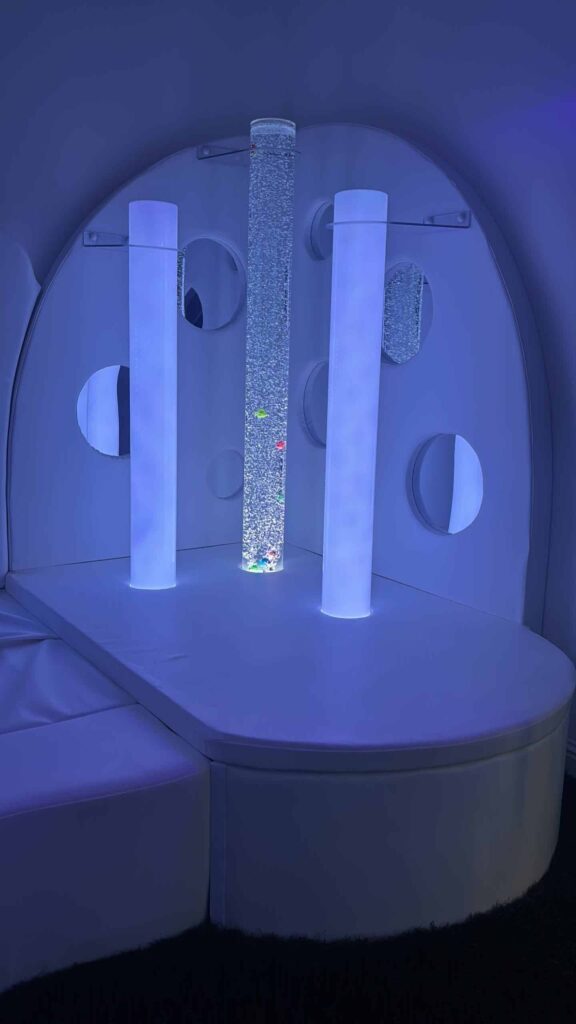Benefits of Sensory Rooms – In today’s world, where sensory overload is a common experience, sensory rooms are becoming a valuable resource for people of all ages and abilities. These specialised spaces are designed to stimulate or calm the senses through a combination of light, sound, textures, and even scents. Whether in schools, healthcare settings, or homes, sensory rooms are providing tremendous benefits for individuals with sensory processing disorders, autism, anxiety, and many other conditions.
What is a Sensory Room and what are the Benefits of Sensory Rooms?
A sensory room is a controlled, safe space equipped with a range of sensory activities designed to promote relaxation or stimulation, depending on the needs of the individual. These rooms often include items like bubble tubes, soft lighting, tactile panels, calming sounds, weighted blankets, and soothing colours. The primary goal is to create an environment where individuals can regulate their sensory input, whether they need to calm down or engage their senses in a more stimulating way.
-
Promotes Emotional Regulation
For individuals with sensory processing issues, such as those with autism or ADHD, sensory rooms can provide an opportunity to regulate their emotions. Overwhelming stimuli—like loud noises, bright lights, or busy environments—can trigger stress, anxiety, and frustration. A sensory room offers a safe haven, where these individuals can escape and find balance.
The variety of sensory tools available in these spaces helps individuals recognize their emotional states and practice self-regulation. Calming activities, like focusing on a bubble tube or listening to soothing music, can help reduce overstimulation and promote emotional equilibrium.
-
Improves Focus and Concentration
While sensory rooms can be calming, they can also be used to boost focus and concentration. Activities like playing with textured objects or using interactive light displays can stimulate the senses in a way that enhances cognitive engagement. This can be particularly beneficial for students with attention difficulties or those who struggle to stay focused for long periods.
By providing a space that caters to the individual’s sensory needs, sensory rooms help promote mental clarity and improve overall attention span. Short sessions in a sensory room during breaks can recharge the brain and lead to better productivity and learning outcomes.
-
Helps with Stress and Anxiety Management
Stress and anxiety are common in individuals with various conditions, including autism, ADHD, and sensory processing disorders. Sensory rooms provide an opportunity to de-escalate from high-stress situations. The sensory inputs, such as soft lighting or tactile stimulation, can trigger the body’s relaxation response, lowering cortisol levels and promoting a sense of calm.
For children or adults dealing with sensory overload, sensory rooms can be a vital tool in managing anxiety and preventing meltdowns. These spaces create a calm, predictable environment where individuals can regain control over their emotions and feel more secure.
-
Supports Sensory Development and Integration
Many individuals with developmental delays or sensory processing disorders have difficulties integrating sensory information from their environment. Sensory rooms help to engage and develop their sensory systems in a way that encourages growth. Activities like tactile play, visual stimulation, or listening to different sounds help the brain process and make sense of sensory input.
For children with autism, for example, sensory rooms provide a structured environment where they can explore and experiment with their senses at their own pace. This type of sensory integration helps build neural pathways that are crucial for development.
-
Fosters Independence and Confidence
Using a sensory room regularly allows individuals to gain better control over their sensory experiences, this is one of the key Benefits of Sensory Rooms. By learning how to identify what soothes or stimulates them, individuals can make informed choices that support their well-being. This increased self-awareness can lead to greater confidence in social situations, school environments, or other areas of daily life.
In schools, for example, students who may struggle with behavior or sensory sensitivities can use the sensory room to self-regulate, allowing them to participate more effectively in class activities and reducing the need for interventions.
-
Creates a Safe Space for All Ages
Sensory rooms are not just beneficial for children; they are an essential resource for adults and elderly individuals as well. In adult care settings, such as hospitals or nursing homes, sensory rooms can offer a retreat for individuals experiencing dementia or other cognitive impairments. Sensory stimulation can improve mood, enhance memory, and reduce agitation in these patients.
In addition, sensory rooms help individuals of all ages cope with various mental health challenges. For example, adults with PTSD or chronic stress disorders can use a sensory room as a tool for grounding themselves and managing overwhelming feelings.
The benefits of sensory rooms are vast and far-reaching, offering a customized approach to emotional regulation, sensory development, and stress management. Whether used in schools, homes, healthcare facilities, or therapy centres, sensory rooms are providing individuals with the tools they need to regulate their sensory experiences and improve their overall quality of life. As awareness of sensory needs grows, sensory rooms are becoming more common, creating safe, supportive environments where everyone—regardless of age or ability—can thrive.
At Inspire Together we offer two sensory spaces, one for relaxation and one for movement.
Contact us today for more information via email in**@in*************.ie or visit our website http://www.inspiretogether.ie
